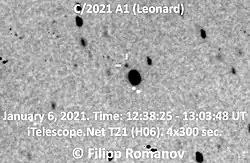C/2021 A1 (Leonard)
C/2021 A1 (Leonard) is an inbound long period comet[4] discovered by G. J. Leonard at the Mount Lemmon Observatory on 3 January 2021 (a year before perihelion) when the comet was 5 AU (750 million km) from the Sun.[1] Jupiter's orbit (5 AU from the Sun) is about the distance from the Sun that methanol (CH3OH) and water start sublimation.[5] This is the first comet discovered in 2021 and has a retrograde orbit. On 12 December 2021 the comet will be 0.233 AU (34.9 million km) from Earth and on 18 December 2021 will be 0.028 AU (4.2 million km) from Venus.[3] It will make its closest approach to the Sun on 3 January 2022. It may reach naked eye visibility in December 2021.[6] At an apparent magnitude of 4, it should be a good binoculars comet. After perihelion the comet will be ejected from the Solar System.
 Long-exposure composite image of comet C/2021 A1 | |
| Discovery | |
|---|---|
| Discovered by | G. J. Leonard |
| Discovery date | 3 January 2021[1] |
| Alternative designations | C4AGJ62 |
| Orbital characteristics A | |
| Observation arc | 273 days |
| Orbit type | long period (inbound) hyperbolic (outbound) |
| Aphelion | ≈3500 AU (barycentric epoch 1950)[2] |
| Perihelion | 0.615 AU |
| Eccentricity | 0.9996 (barycentric epoch 1950)[2] 1.000017 (barycentric epoch 2100) |
| Orbital period | ≈70000 yr (inbound)[2] |
| Inclination | 132.68° |
| Node | 255.86° |
| Argument of periapsis | 225.09° |
| Earth MOID | 0.2306 AU (34.50 million km)[3] |
| Jupiter MOID | 0.2972 AU (44.46 million km) |
| Comet total magnitude (M1) | 5.3 |
| Next perihelion | 3 January 2022 (followed by ejection) |
Using an epoch of 1950 which is well before the comet entered the planetary region of the Solar System, a barycentric orbit solution suggests the comet had roughly a 70 thousand year orbital period.[2] Therefore the comet had spent the last 35 thousand years inbound from approximately 3,500 AU (520 billion km). The barycentric orbit will remain hyperbolic after September 2022.[2]
References
- "MPEC 2021-A99 : COMET C/2021 A1 (Leonard)". minorplanetcenter.net. Retrieved 2021-01-10.
- Horizons output. "Barycentric Osculating Orbital Elements for Comet C/2021 A1 (Leonard)". Retrieved 2021-01-13. (Solution using the Solar System's barycenter (Sun+Jupiter). Select Ephemeris Type:Elements and Center:@0) Epoch 1950 has PR= 2.64E+07 / 365.25 = 72000 years
- "C/2021 A1: Close-Approach Data". JPL Small-Body Database Browser. Retrieved 2021-01-10.
- CBET 4907: original 1/a = +0.000575 (long-period) and future 1/a = -0.000030 (hyperbolic). The orbital energy is inversely proportional to negative semi-major axis. Objects in hyperbolic orbits have negative semi major axis, giving them a positive orbital energy.
- Figure 3 Chandler (2020)
- Magnitude estimate – Seiichi Yoshida